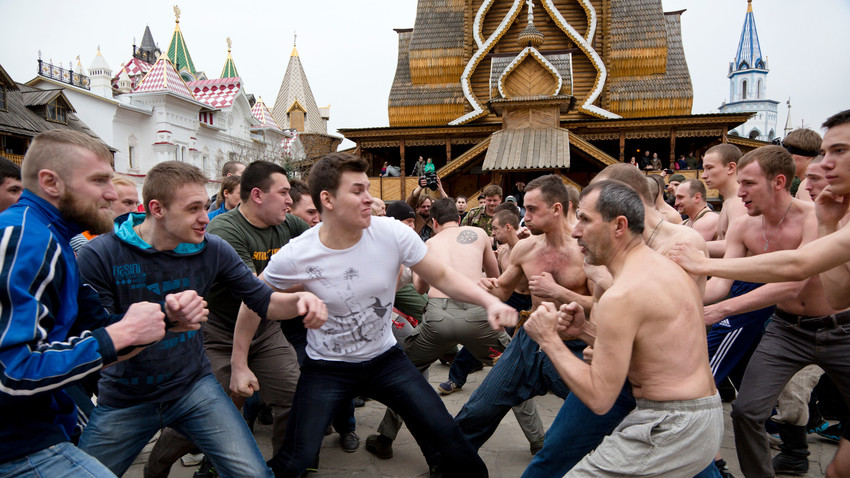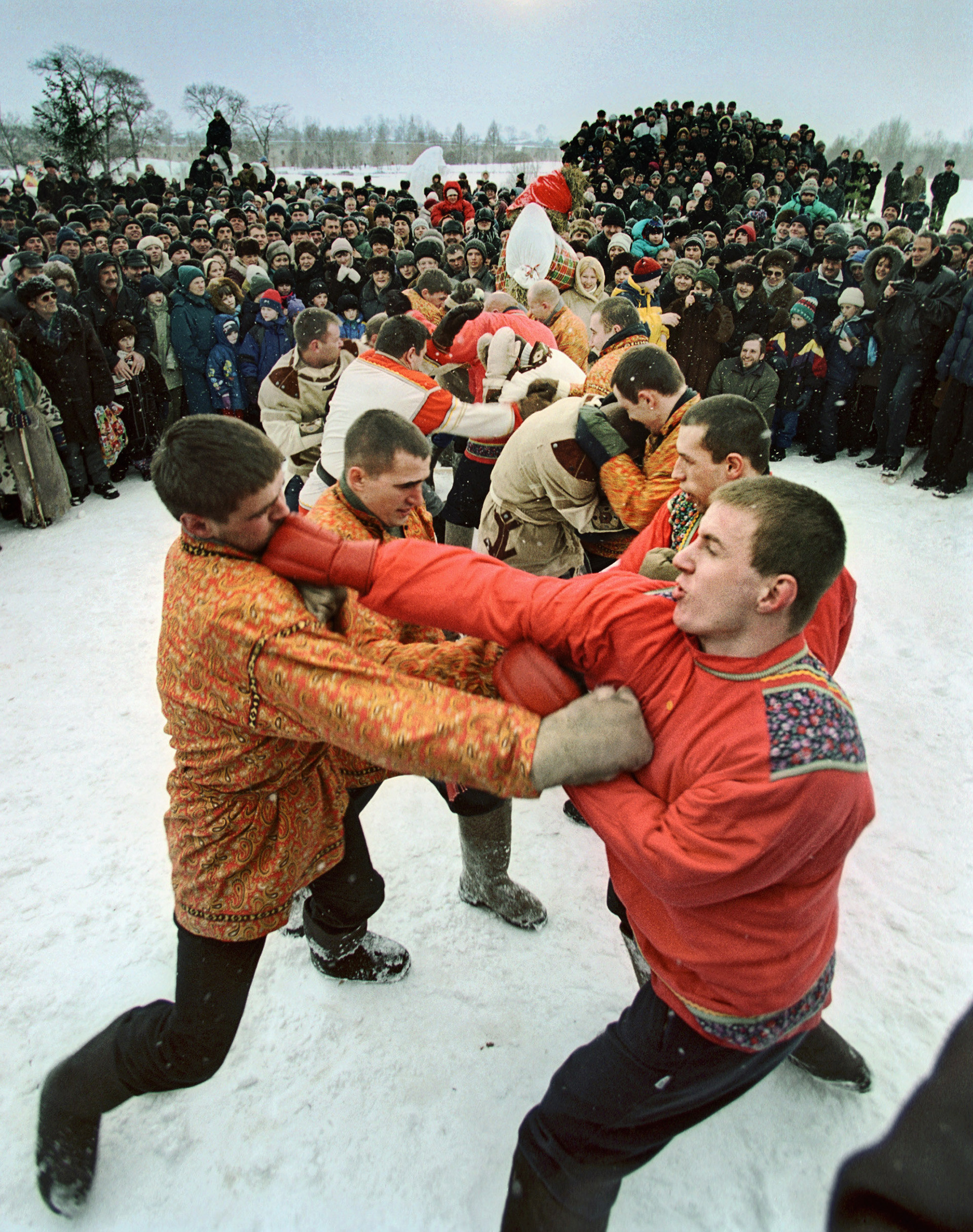
Historical reenactment of a Russian fist fight in Izmailovo, Moscow
Legion Media1. Wait for the holiday
In Russia, traditional fist fights took place on major holidays, but especially around New Year's and before the beginning of the agricultural season when the old life symbolically gave way to the new.
Historians agree that in the pagan worldview fights on such occasions symbolized the struggle between the old and new. These kind of fights were always in teams, and individual fights were only a warm-up to the big brawl.
2. Know your rights
The Russian Orthodox Church was always against fist fighting because of its pagan origins. The state officially condemned such fights, but it turned a blind eye because fist fighting was an important way to prepare the male population for military combat.
In the 1740s, the Church appealed to the Governing Senate to enact a ban on fist fighting, but the senators firmly refused because it was a masculine and healthy tradition, and a ban would only enrage the people. Police stood by as mass fist fights raged, and also because it’s simply impossible to stop and apprehend 500 men who are fighting each other.
3. Assemble your team

Russian fist fight as shown in the movie "The Barber of Siberia" by N. Mikhalkov.
VideoLandFist fights were held in wide open spaces in winter, such as on a frozen lake or pond, and during the warmer months in a meadow. The most popular and spectacular mass brawls, also called “wall-on-wall” fights, were between two large teams: the left side of the village street versus the right side, or one village against another.
In cities, fights between craftsmen guilds were common— butchers versus shoemakers, or one factory against another. In 19th century Russia, if you were proficient in fist fighting, it could get you a good job because wealthy merchants and factory owners preferred to employ able fighters. Defeating a rival factory was a matter of honor.
4. The tactics
Every “wall” had its leader, who on the eve of the fight gathered his boys for a tactical briefing. Together with the most experienced fighters, the leader worked out the fight’s timing and strategy — for example, when flanks would close in on the opposing “wall,” and when the strongest and largest fighters, the “hope” of the team, entered the fray (they were held in reserve until a tough moment). During the fight, leaders cheered on their teams and implemented tactics, while themselves fighting.
5. Sleep, eat, and get your fighting clothes on
Fist fights didn’t require special training, and experience could only be gained in action. Before the fight day, men went to the bathhouse, got a good sleep and ate well. There was never a habit to fight drunk — everyone understood that fighting is serious and could be deadly. To avoid that, fighters put on gloves and hats to soften opponent’s blows.
Spectators also prepared for the big brawl, and entire villages gathered to watch the fight, with peddlers selling beer and an alcoholic honey drink. Meanwhile, noblemen and wealthy merchants came from nearby towns and villages to watch and make bets.
Some noblemen even joined the fighting. Count Fyodor Rostopchin, Moscow’s governor, was trained in English boxing and loved to fight. Prince Grigory Orlov, Catherine the Great’s lover, was also a brawler.
6. Start off in style

An episode from a fist fight (19-century illustration)
Fedor Solntsev/WikipediaA fight began with much fanfare, with fighters proceeding down main street to the place of combat. There, they split up and began to taunt each other with playful insults and caustic jokes. Sometimes, a harmonica was played to raise morale. Young boys from both sides started the fight, and then teenagers would set in. The real show began when grown-up married men began swinging their fists (boys formed a separate fight next to them).
7. Have a clean fight
Fist fights were not about rage or winning at any cost. If fist fights had ended in death, then they’d not be so popular. To avoid tragedy, there were rules:
1) Don’t attack those lying on the ground or bleeding profusely;
2) Don’t attack spectators and passersby;
3) Don’t attack anyone from behind or from the flanks;
4) Don’t put heavy objects inside your gloves. For violating this rule, you could get whacked by members of your own team and be banned from fighting, which was a horrible stigma; taking part in fist fights was crucial for a village man’s honor;
5) Your only weapon was your fists (no kicking or using an object in a fight);
6) No defecting to the opposite side during the fight; sometimes, fights ended in the evening and resumed the next day; so you had to stay with your side.
8. Taking breaks
Some holidays were quite long, so fighters could take a break and continue the next day. Usually, fighting started in the afternoon and proceeded with one or two breaks until darkness, to be continued the next day. During breaks opponents gathered to drink, rest, discuss the fight and have a good laugh. It was crucial to show that the fight was a man’s healthy pastime, not a serious and malicious conflict.
9. Defeat the opponent, and bask in the glory

A tradtional fist fight during the Shrovetide celebrations in Suzdal
Sergey Metelitsa/TASSAfter several breaks, it became clear that one side was stronger than the other, and this was the moment to chase the opponents from the field and drive them to the village outskirts. At this point victory had been achieved, and everybody from both “walls” got together for a meal and a drink. The winning team got all the glory, the admiration of the ladies and respect from elders —until the next fight, of course.
If using any of Russia Beyond's content, partly or in full, always provide an active hyperlink to the original material.
Subscribe
to our newsletter!
Get the week's best stories straight to your inbox